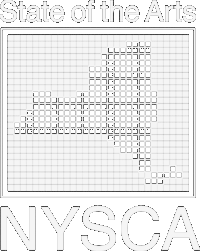![]()
Explore Korean culture through dance! Participants will enjoy learning six exciting types of Korean dance including: HalRyang Mu (한량무), Sogo Ch’um (소고춤), Bong San Tal Ch’um (봉산탈춤), Ip Ch’um (입춤), Salpuri Ch’um (살풀이), and Kpop. Experienced teaching artist Karen Kriegel develops micro choreographies based on longer dance pieces to provide a sampler of the basic movements, music, rhythm, and various dance styles within traditional Korean dance. Supported by New York State Council for the Arts.
September 29-November 24, 2014 | Mondays 6 PM - 8 PM
All are welcomed to participate in this workshop series. Dance experience is not necessary. All ages, body types, abilities, and genders are encouraged to join.
For educators, lesson plans with Common Core connections for various grades are supplied.
Session Schedule & Descriptions
September 29, 2014
한량무 HalRyang Mu Fan Dance “The Scholar’s Dance”
Influenced by Confucian thought, this dance focuses on the fan technique. HalRyang Mu reflects the joy felt by an young accomplished Confucian scholar as he looks to a bright future.
October 6, 2014
소고춤 Sogo Ch’um Small Drum Farmer’s Dance
Using movements from the various forms of 농악 (farmer’s music), this dance was performed outdoors during seasonal celebrations and village events. The choreography focuses on both individual and team movements, while utilizing a small handheld drum.
October 27, 2014
봉산탈춤 - 먹중 Bong San T’al Ch’um - Meokjung Mask Dance
Designated the 17th Important Intangible Cultural Property of Korea by the Korean government in 1967, this mask dance is a form of socio-political theater that uses playfulness and satire to raise community issues and question authority. The masks, or 탈 (t’al), are props intended to ridicule members of society. The drama consists of seven acts and can last several hours. This workshop focuses on the first l6 PMevel of study, or 기본 (kibon), from Act 2 for a character known as 목중 (meokjung). This dance is also known as “The dance of the eight young monks who like to play and do whatever they can to avoid their studies.”
November 3, 2014
입춤 Ip Ch’um I “Free Dance”
This traditional style typifies the movements found in Korean dance forms, and display the true nature of the Korean aesthetic. Using breath and curved lines of the body, the dance is an illusion of ease and free-flowing improvisation. In actuality, it is highly choreographed using every muscle in the body and controlled breathing.
November 10, 2014
살풀이 Salpuri Ch’um Scarf and Shaman Dance
This stage technique is influenced by the female shamans of the Korean peninsula. Multiple elements of theater, Confucian, Buddhist, and Shamanistic histories, as well as feminist theory, are used in this piece. Emotional transformation defines this dance form.
November 24, 2014
Kpop and Hallyu
Korean pop music and dance have quickly spread to all corners of the globe. Through resources such as YouTube, Kpop is strongly identified with Korea. This workshop will feature a popular choreography and provide a basic history of the dance form within Hallyu, the Korean culture wave.

Art Workshop: Korea Through Dance is made possible by the New York State Council on the Arts with the support of Governor Andrew Cuomo and the New York State Legislature.

